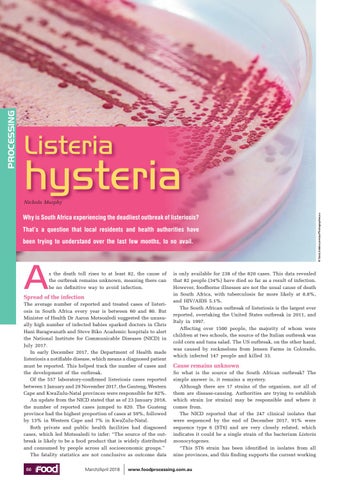hysteria Nichola Murphy
Why is South Africa experiencing the deadliest outbreak of listeriosis? That’s a question that local residents and health authorities have been trying to understand over the last few months, to no avail.
A
s the death toll rises to at least 82, the cause of the outbreak remains unknown, meaning there can be no definitive way to avoid infection.
Spread of the infection The average number of reported and treated cases of listeriosis in South Africa every year is between 60 and 80. But Minister of Health Dr Aaron Motsoaledi suggested the unusually high number of infected babies sparked doctors in Chris Hani Baragwanath and Steve Biko Academic hospitals to alert the National Institute for Communicable Diseases (NICD) in July 2017. In early December 2017, the Department of Health made listeriosis a notifiable disease, which means a diagnosed patient must be reported. This helped track the number of cases and the development of the outbreak. Of the 557 laboratory-confirmed listeriosis cases reported between 1 January and 29 November 2017, the Gauteng, Western Cape and KwaZulu-Natal provinces were responsible for 82%. An update from the NICD stated that as of 23 January 2018, the number of reported cases jumped to 820. The Guateng province had the highest proportion of cases at 59%, followed by 13% in Western Cape and 7% in KwaZulu-Natal. Both private and public health facilities had diagnosed cases, which led Motsoaledi to infer: “The source of the outbreak is likely to be a food product that is widely distributed and consumed by people across all socioeconomic groups.” The fatality statistics are not conclusive as outcome data 66
March/April 2018
is only available for 238 of the 820 cases. This data revealed that 82 people (34%) have died so far as a result of infection. However, foodborne illnesses are not the usual cause of death in South Africa, with tuberculosis far more likely at 8.8%, and HIV/AIDS 5.1%. The South African outbreak of listeriosis is the largest ever reported, overtaking the United States outbreak in 2011, and Italy in 1997. Affecting over 1500 people, the majority of whom were children at two schools, the source of the Italian outbreak was cold corn and tuna salad. The US outbreak, on the other hand, was caused by rockmelons from Jensen Farms in Colorado, which infected 147 people and killed 33.
Cause remains unknown So what is the source of the South African outbreak? The simple answer is, it remains a mystery. Although there are 17 strains of the organism, not all of them are disease-causing. Authorities are trying to establish which strain (or strains) may be responsible and where it comes from. The NICD reported that of the 247 clinical isolates that were sequenced by the end of December 2017, 91% were sequence type 6 (ST6) and are very closely related, which indicates it could be a single strain of the bacterium Listeria monocytogenes. “This ST6 strain has been identified in isolates from all nine provinces, and this finding supports the current working
www.foodprocessing.com.au
© Stock.Adobe.com/au/Photographee.eu
PROCESSING
Listeria
